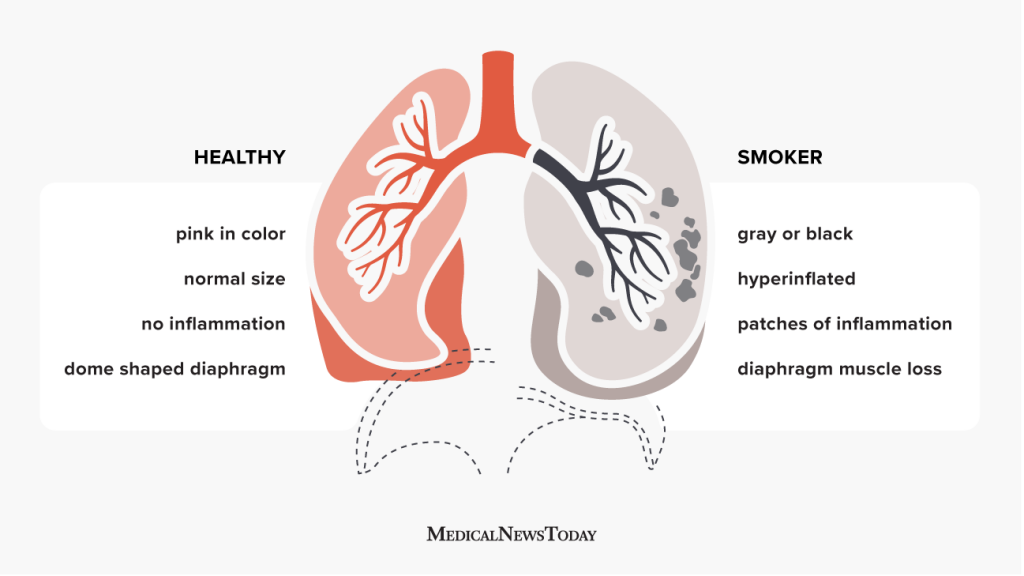Abstract:
This experiment aims to demonstrate the presence of tar in cigarette smoke and its effects on lung health. Tar is a harmful substance found in cigarette smoke, which can lead to various respiratory diseases and lung cancer.
Introduction:
Cigarette smoking is a major public health concern worldwide, contributing to numerous preventable deaths each year. Tar is one of the many toxic components present in cigarette smoke, consisting of various harmful chemicals and carcinogens. The deposition of tar in the lungs can lead to respiratory issues, decreased lung function, and an increased risk of developing lung cancer.
In this experiment, we will demonstrate the presence of tar in cigarette smoke using a simple filtration method. Additionally, we will compare the visual differences between the lungs of smokers and nonsmokers to highlight the adverse effects of tar on lung health.
Procedure:
- Obtain a cigarette and a clean piece of filter paper.
- Light the cigarette and allow it to produce smoke.
- Direct the smoke through the filter paper using a tube or funnel.
- Observe the filter paper for the presence of tar residue.
- Collect lung images of smokers and nonsmokers for comparison.
Observations:
After passing the cigarette smoke through the filter paper, a brownish residue, indicative of tar, was observed on the paper surface. The intensity of the residue varied depending on the duration and intensity of smoke exposure.
Upon comparing the lung images of smokers and nonsmokers, significant differences were observed. Smokers exhibited darker and discolored lungs with visible tar deposits, while nonsmokers had cleaner and healthier-looking lungs.
Precautions:
- Perform the experiment in a well-ventilated area to minimize exposure to smoke.
- Handle cigarettes and smoking apparatus with caution to prevent accidents.
- Dispose of cigarette remnants and filter paper properly to avoid environmental contamination.
- Avoid direct inhalation of cigarette smoke to prevent health risks.
Conclusion:
This experiment demonstrates the presence of tar in cigarette smoke and its detrimental effects on lung health. The visual evidence of tar deposition in the lungs highlights the importance of smoking cessation and tobacco control measures in promoting respiratory well-being.
Questions and Answers
-
What is the aim of the experiment?
The aim is to demonstrate the presence of tar in cigarette smoke and its effects on lung health.
-
What is tar?
Tar is a harmful substance found in cigarette smoke, consisting of various toxic chemicals and carcinogens.
-
How is tar presence in cigarette smoke demonstrated?
Tar presence is demonstrated by passing cigarette smoke through filter paper and observing the residue.
-
What are the effects of tar on lung health?
Tar can lead to respiratory issues, decreased lung function, and an increased risk of lung cancer.
-
What is the filtration method used in the experiment?
A simple filtration method using filter paper is used to trap tar from cigarette smoke.
-
Why is it important to perform the experiment in a well-ventilated area?
To minimize exposure to smoke and potential health risks associated with inhalation.
-
What are the visual differences observed in the lungs of smokers and nonsmokers?
Smokers' lungs exhibit darker coloration and visible tar deposits compared to the cleaner lungs of nonsmokers.
-
What precautions should be taken during the experiment?
Precautions include handling smoking apparatus with caution and proper disposal of cigarette remnants.
-
How can the experiment contribute to public health awareness?
By visually demonstrating the harmful effects of tar on lung health, it can promote smoking cessation and tobacco control measures.
-
What is the conclusion drawn from the experiment?
The experiment highlights the presence of tar in cigarette smoke and emphasizes the importance of smoking cessation for respiratory well-being.
Multiple Choice Questions and Answers
-
What is the primary aim of the experiment?
A. To promote cigarette smoking
B. To demonstrate the presence of tar in cigarette smoke and its effects on lung health
C. To test the effectiveness of air purifiers
D. To study the effects of exercise on lung capacity
Answer: B -
What is tar?
A. A type of gum
B. A component of cigarette smoke
C. A type of candy
D. A synthetic fabric
Answer: B -
How is tar presence in cigarette smoke demonstrated in the experiment?
A. By measuring the temperature of cigarette smoke
B. By using a microscope
C. By passing cigarette smoke through filter paper
D. By conducting a chemical analysis
Answer: C -
What are the effects of tar on lung health?
A. Improved lung function
B. Reduced risk of lung cancer
C. Respiratory issues and increased risk of lung cancer
D. No effect on lung health
Answer: C -
Why is it important to perform the experiment in a well-ventilated area?
A. To increase the concentration of cigarette smoke
B. To reduce exposure to smoke and potential health risks
C. To prevent filter paper from burning
D. To improve visibility of tar residues
Answer: B
🔗 Other Useful Links
- News By Amurchem
- Free Web Development Course
- All-in-One Exam Prep Portal
- Articles by Amurchem
- Grade 12 Section
- Grade 11 Section
- Grade 10 Section
- Grade 09 Section
- Advanced Artificial Course
- Home and Online Tuition
- Labs By Amurchem
- Science Lectures By Amurchem
- Social Media Executive Course
© 2025 AmurChem. All rights reserved.







Thank you sir
ReplyDelete